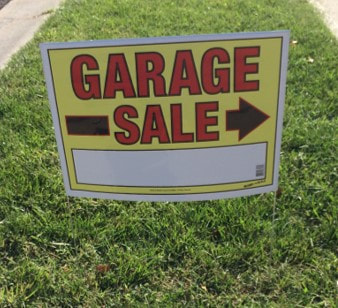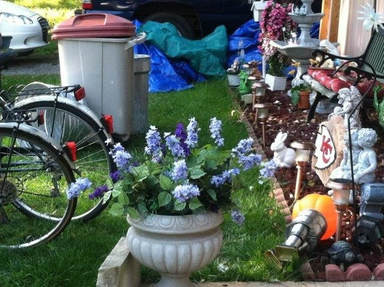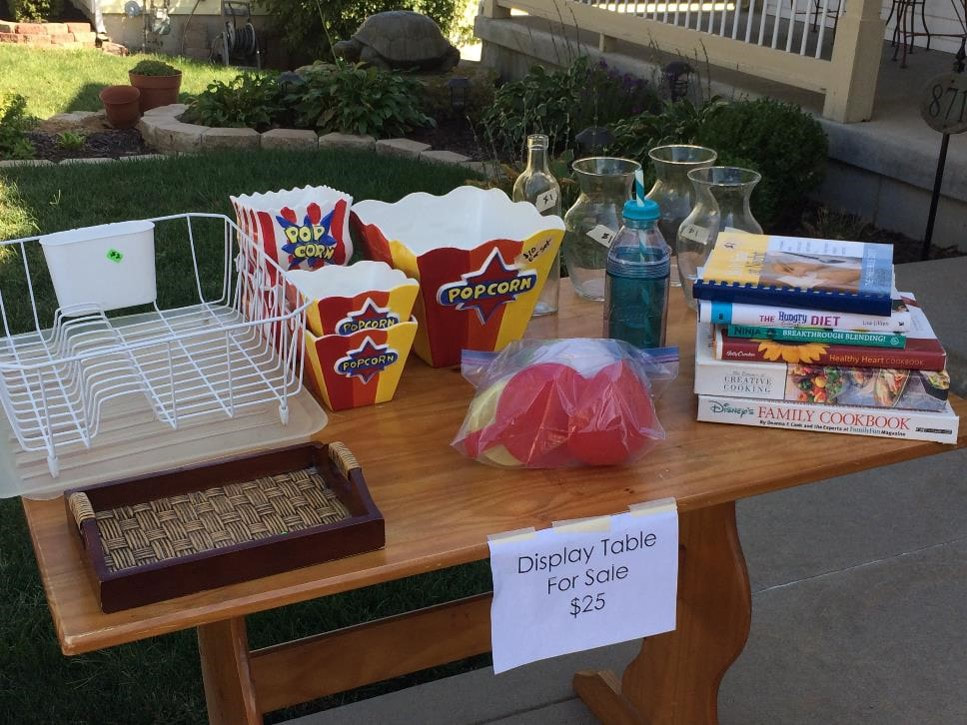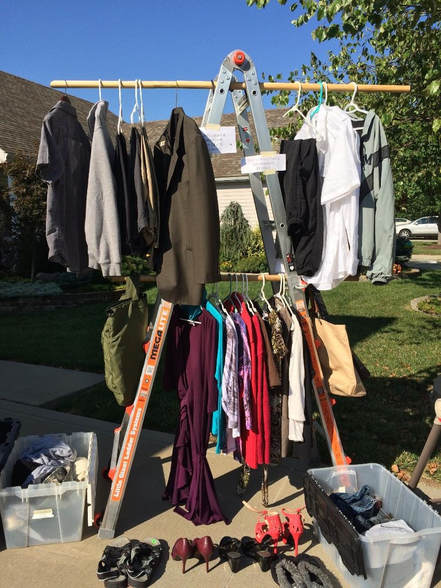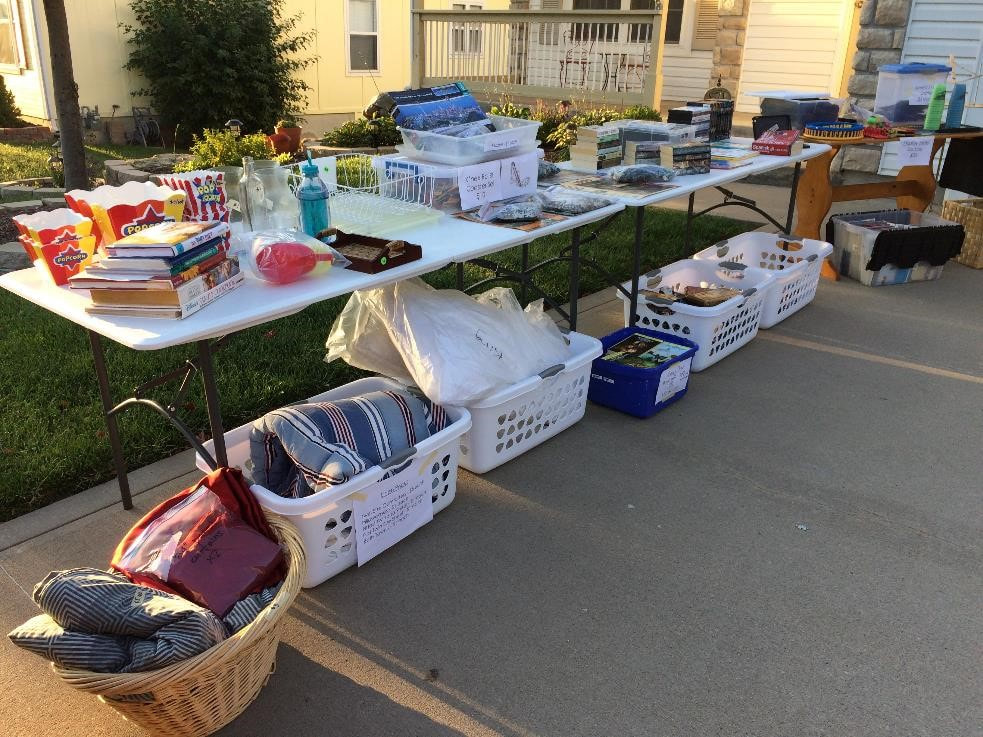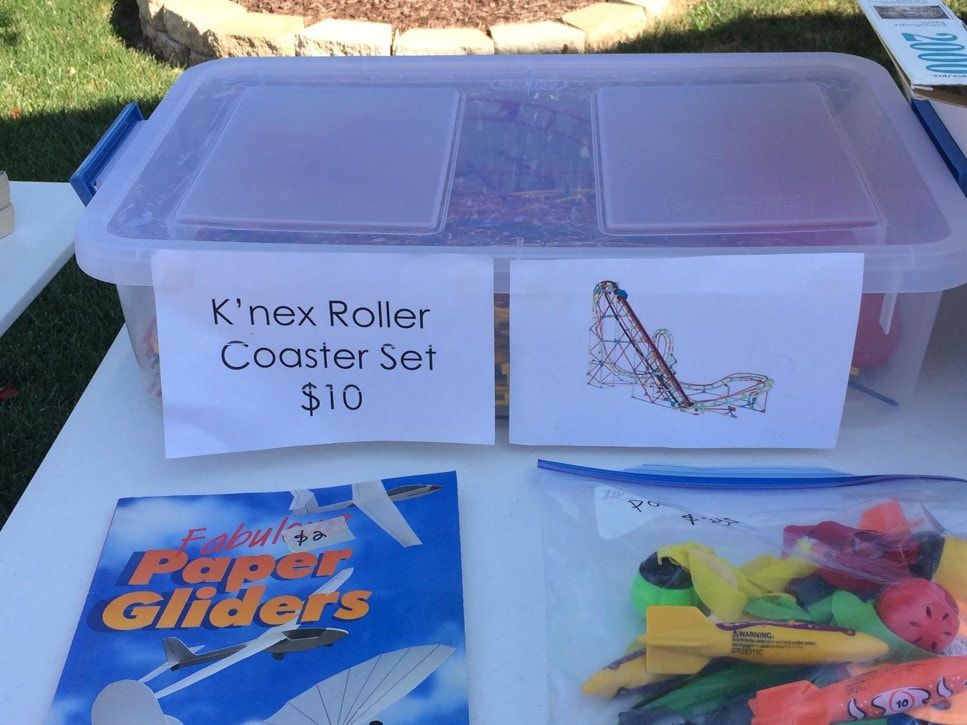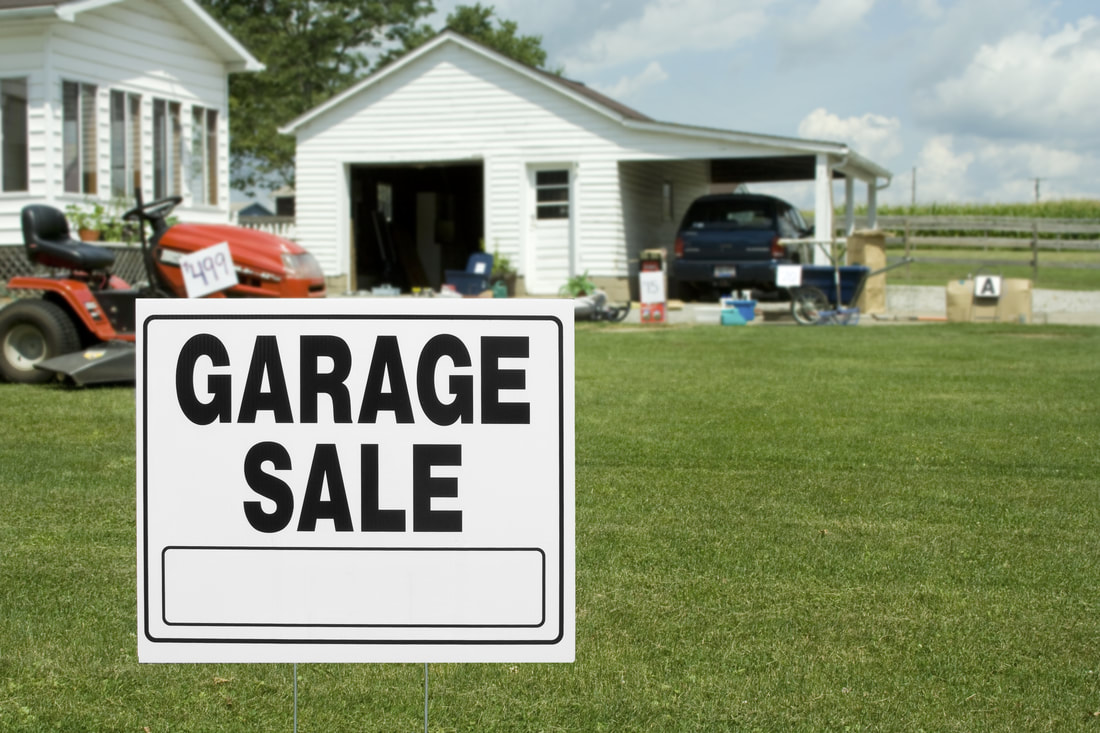|
|
Garage Sale Organization Tips |
|
A garage sale is a great way to pass on unwanted, unneeded, or unused stuff, but such sales can be a lot of work for very little gain if poorly planned. A little extra effort can go a long way. Follow these simple tips to increase the success of your next sale.
#1 - Check the weather and the calendar |
|
While the weather can be unpredictable at times, it’s useful to try and plan around it. Hold your garage sale at a time of year when rain showers and other weather-related deterrents are less likely and keep an eye on the forecast as your sale date draws near.
#2 - Check the Calendar |
|
It is also a good idea to take a peek at the community calendar. Is there an event taking place the same weekend that is likely to draw potential customers away? On the other hand, there may be an event coming up which will bring local people out and attract outsiders to town thereby increasing your sale’s exposure.
Does your neighborhood or town have plans for a community-wide garage sale? If so, plan to sell your stuff the same weekend. Even people who normally pass garage sales by often come out for such widespread events.
Does your neighborhood or town have plans for a community-wide garage sale? If so, plan to sell your stuff the same weekend. Even people who normally pass garage sales by often come out for such widespread events.
#3 - Advertise |
|
|
Post fliers advertising your garage sale on neighborhood bulletin boards or in community newsletters. Check with your municipality and homeowners’ association to find out what restrictions, if any, exist regarding the posting of signs. Be sure to follow regulations and be sure to collect any signs that you’ve posted as soon as the sale is over.
Utilize free online sources such as Craigslist, gsalr.com, or yardhopper.com to advertise as well. Provide a detailed list of the kinds of items you’ll be selling and even post pictures of items you think will be particularly attractive to buyers. Post your ads a couple of weeks in advance. |
Recommended Reading
Check out these tips from for creating garage sale ads that attract buyers from Best Garage Sale Tips.
|
#4 - Purge |
|
The whole point of a garage sale is to get rid of stuff you don't want or need, and purging is the place to begin. Set up a designated spot in your garage, basement or other storage area. Gather several boxes in which to store items until the sale.
Save time and effort by organizing items into groups as you collect them. Have a box for books, one for toys, one for household items, one for electronics, one for sporting goods, and so forth according to your needs. Price each item before placing it in the appropriate box.
Rather than run to your designated storage space every time you identify a new candidate for your garage sale, place a catchall box in a more central location. Place individual items in the catchall box as you come across them. Once every few days sort the contents of the catchall box into the appropriate storage boxes.
Save time and effort by organizing items into groups as you collect them. Have a box for books, one for toys, one for household items, one for electronics, one for sporting goods, and so forth according to your needs. Price each item before placing it in the appropriate box.
Rather than run to your designated storage space every time you identify a new candidate for your garage sale, place a catchall box in a more central location. Place individual items in the catchall box as you come across them. Once every few days sort the contents of the catchall box into the appropriate storage boxes.
#5 - Wash everything |
|
While you will find the occasional visionary who can appreciate old things for their potential, most people are not inclined to spend money on stuff that looks grubby or dingy. People attend garage sales looking for bargains, not junk. The idea is to save money, not waste it.
Make your customers want what you have to offer. Take the time to clean things before you display them and increase the sellability of your stuff. Dust electronics, wipe down toys and appliances, and wash all linens and clothing before you try to sell them.
Make your customers want what you have to offer. Take the time to clean things before you display them and increase the sellability of your stuff. Dust electronics, wipe down toys and appliances, and wash all linens and clothing before you try to sell them.
#6 - Be prepared |
|
As much as possible, set up for your garage sale the night before. Be up and ready with time to spare so that you can accommodate customers as soon as they start to arrive. Even if you indicate no early birds in your advertisements, people will show up early.
You can always turn customers away, asking them to come back later, but by doing so you risk losing business. If they are dedicated garage-salers (and they most likely are if they are out and about that early), they’ve probably mapped out a route for the day which does not include doubling back.
You can always turn customers away, asking them to come back later, but by doing so you risk losing business. If they are dedicated garage-salers (and they most likely are if they are out and about that early), they’ve probably mapped out a route for the day which does not include doubling back.
#7 - Separate the non-sale items |
|
|
If yours is a true garage sale, meaning you are holding it in your garage, you will want to make sure that any items you do not wish to sell are out of sight. This will eliminate confusion on the part of your customers and prevent any well-meaning assistants from accidentally selling something you intended to keep. At this garage sale I recently visited (pictured right), it was difficult to tell what was for sale and what was part of the normal yard décor.
|
#8 - Enlist help |
|
Speaking of assistants, it’s a good idea to have at least one helper handy to relieve you should you need to step away from the sale for any reason. Having help also allows you to assist multiple customers at the same time.
When enlisting assistants, be sure to brief them on organization and pricing. Ideally, they should be able to answer any questions that might arise in your absence without having to refer to you.
When enlisting assistants, be sure to brief them on organization and pricing. Ideally, they should be able to answer any questions that might arise in your absence without having to refer to you.
#9 - Consider your needs |
|
Pack a lunch the night before. Keep a water bottle handy. Set out chairs for yourself and any helpers who may be assisting you. Stash a book out of sight (so it won't get sold!) to entertain yourself during lulls in traffic. By preparing for your needs in advance, you will be able to maintain your energy level and remain accessible to customers throughout your garage sale.
#10 - Thoughts on pricing |
|
Price everything. I know. It seems like a lot of work, but it is well worth the effort. The advantages of pricing everything are many. By clearly indicating prices you remove the hassle of constantly having to answer questions regarding price. You also save customers the hassle of having to ask about prices. If a potential customer isn't sure about a price and you are busy helping someone else, they may pass the item by rather than wait for you to become available. Another advantage of pricing everything is that anyone assisting you can be confident regarding the price of items without having to hunt you down.
Pricing Tips:
- You can price everything without placing a sticker on each and every item. Related items can be grouped together and labeled with a common price. For instance, if you have a lot of books to sell, designate a table for books and post a sign explaining the pricing (i.e. all paperbacks $1, hardbacks $2). Small items can also be grouped together in bins or baskets and the basket labeled with a price.
- If you’re not sure how to price an item, you can always put a sign on it saying “Make me an offer.” Make sure anyone assisting you knows the minimum amount to accept for the item.
- Stick to even dollar amounts as much as possible. If you price items under a dollar, do so in increments of 25 cents to make giving change and figuring totals easier.
- Offer discounts for buying in bulk (i.e. 25 cents each or 5 for $1).
- If a customer is looking like they're afraid to commit, try offering them a deal. For instance, if they are considering multiple items that combined would add up to $20, offer to sell them everything for $15. It's a bargain for them, and it limits what you have to haul off at the end of the day. Something is always better than nothing, even if it isn't what you hoped for.
- If sales are sluggish or it’s nearing the end of the day and you still have a lot of stuff to sell, consider lowering your prices to entice late afternoon shoppers.
|
|
Be Ready to Bargain
|
|
Serious garage sale goers are likely to try and bargain with you, even if the asking price is clearly indicated. You will most likely have many items which you simply want to get rid of. In such cases, you will no doubt be open to bargaining so long as you can get someone to take them off your hands and make a little something in exchange.
You may also have some items you hope to sell, but which you are only willing to part with for a certain price. As you think through pricing, ask yourself what your bottom line is. What is the item worth to you?
Create a master list indicating the asking price of such items and the bare minimum you will accept. By so doing, you will save yourself frustration should someone wish to bargain with you. Without having to think about it while under pressure, you can confidently express the minimum offer you are willing to accept.
You may also have some items you hope to sell, but which you are only willing to part with for a certain price. As you think through pricing, ask yourself what your bottom line is. What is the item worth to you?
Create a master list indicating the asking price of such items and the bare minimum you will accept. By so doing, you will save yourself frustration should someone wish to bargain with you. Without having to think about it while under pressure, you can confidently express the minimum offer you are willing to accept.
#11 - Keep stuff straight |
|
If your garage sale is communal, color code items with stickers to make it easier for everyone to identify who gets credit for each sale. Create a master list with a key indicating which color sticker represents each seller. Your list can be as simple as a series of columns each with a colored sticker at the top and a name indicating whose items are labeled with that color. Within each column keep a running tally of sales and divide up the proceeds accordingly at the end of the day.
#12 - Gather supplies |
|
You will want to have a large supply of boxes, baskets, bins and crates on hand for displaying your wares. In addition, you will need multiple surfaces on which to display things.
If possible, avoid setting items out on a blanket or tarp on the ground. This limits maneuverability and makes it hard for people who have difficulty bending to look at things. In addition, you risk items becoming damaged or dirty.
Instead, gather folding tables, patio furniture, saw horses with plywood set on top, and empty shelving units for displaying your stuff. You can even use large plastic storage containers as platforms.
If possible, avoid displaying merchandise on a piece of furniture you wish to sell. If you need the furniture as display space, be sure to post a sign on it indicating it's for sale.
If possible, avoid setting items out on a blanket or tarp on the ground. This limits maneuverability and makes it hard for people who have difficulty bending to look at things. In addition, you risk items becoming damaged or dirty.
Instead, gather folding tables, patio furniture, saw horses with plywood set on top, and empty shelving units for displaying your stuff. You can even use large plastic storage containers as platforms.
If possible, avoid displaying merchandise on a piece of furniture you wish to sell. If you need the furniture as display space, be sure to post a sign on it indicating it's for sale.
Whenever possible, hang clothing. This is a more flattering way to display clothes. It’s also a much easier way for customers to see and sort through clothing. Use a portable clothing rack or an existing clothesline.
|
You can also create a temporary setup by tying clothesline between two trees or poles or balancing a broom handle between two ladders placed a few feet apart. If using ladders, make sure they are secure and will not tip over as items are removed and replaced. Drape clothing and linens over the rungs of a ladder for additional display space.
If some form of clothesline is not possible, place clothing in bins according to gender/size and label clearly. Rather than pricing each item individually, establish a standard (i.e. blouses $2, dresses $5, etc.) and post signs. In addition to gathering supplies for displaying merchandise collect plastic bags for customers to carry their purchases in and newspaper or tissue paper for wrapping breakables. Have scissors, tape, and twine handy as well. |
#13 - Handling cash |
|
Before the garage sale make sure you have plenty of change on hand. Focus on small bills (1’s, 5’s, and 10’s). Also have a few dollars in quarters available if you've priced items under a dollar.
Rather than using a cash box which needs to be manned, consider wearing an apron with pockets. Another good option is a waste/butt pack with a zippered pouch. Along with the cash, carry a calculator for figuring totals. These options allow you to move through the crowd answering questions and assisting customers rather than sitting beside the cash box waiting for them to come to you.
Rather than using a cash box which needs to be manned, consider wearing an apron with pockets. Another good option is a waste/butt pack with a zippered pouch. Along with the cash, carry a calculator for figuring totals. These options allow you to move through the crowd answering questions and assisting customers rather than sitting beside the cash box waiting for them to come to you.
#14 - Create an eye-catching display |
|
As you set up your display keep the following in mind:
- Display your most alluring items right out front to attract passers-by.
- Group like items together. A mixed up jumble of unrelated things can be a turn off to visitors - too much effort for too little gain. Folks are much more likely to have a good look at the merchandise if they can easily identify the types of items you're offering and the selection you have available. Follow a department store model with clothing in one area, housewares in another, toys in another, and so forth.
- Arrange items in such a way that everything can easily be seen and accessed. Obviously, people can't buy what they can't see. Likewise, if visitors have to crawl over piles of stuff to get to an item that interests them, they're much more likely to pass it by.
- Look for interesting and attractive ways to display items. Use matching bins or baskets, wooden crates, and other decorative means of showing off your merchandise.
- Items with multiple parts should be grouped together in a baggie or storage container. If using a storage container, include the container in the cost of the item. Put a picture of the assembled item on the front of the bag or container so customers can clearly see what the item looks like when assembled.
#15 - Know your stuff |
|
Collect any warranties or instruction manuals you have on hand for items you wish to sell. These will serve as a resource for you in answering any questions that might arise about a particular item and should be passed on to the new owner after a sale. Whether or not a particular product has an instruction manual, make sure you know how it works, what it's for, how old it is, etc.
I once tried to sell a used item that I had been given at a garage sale. The problem was, I wasn't sure what it was. I optimistically hoped that someone else would not only recognize it, but also have a desire to take it off my hands. Such was not the case. Instead, I received a number of questions regarding the item, none of which I was able to answer. Not surprisingly, it didn't sell.
Your ability to answer questions regarding your merchandise gives your customers confidence in you and increases your credibility as a reliable seller. In contrast, an apparent lack of knowledge can leave you and/or your stuff looking suspect in the eyes of potential buyers.
I once tried to sell a used item that I had been given at a garage sale. The problem was, I wasn't sure what it was. I optimistically hoped that someone else would not only recognize it, but also have a desire to take it off my hands. Such was not the case. Instead, I received a number of questions regarding the item, none of which I was able to answer. Not surprisingly, it didn't sell.
Your ability to answer questions regarding your merchandise gives your customers confidence in you and increases your credibility as a reliable seller. In contrast, an apparent lack of knowledge can leave you and/or your stuff looking suspect in the eyes of potential buyers.
#16 - Have a power source handy |
|
Wherever you choose to hold your sale, make sure you have access to an electrical outlet. If necessary, keep an extension cord handy as well. Invite potential buyers to try out electronic items - everything from kitchen appliances to home entertainment items to electric blankets.
If you've got the space and you’re protected from an unwelcome rain shower, consider demonstrating the serviceability of certain items where appropriate. For instance, play background music on a stereo you wish to sell so that customers can hear the sound quality. Set up a game system and TV and invite folks to try it out.
This principle also applies to battery operated toys and other items. You are much more likely to sell an item with fresh batteries in it. For one thing, buyers will be able to see the item in action and know that it works. In addition, they have the convenience of knowing that they can use it right away rather than having to make a trip to the store to buy batteries first.
Don't be shy about demonstrating items for people who look interested. Step right up and ask them if they'd like to give it a try.
If you've got the space and you’re protected from an unwelcome rain shower, consider demonstrating the serviceability of certain items where appropriate. For instance, play background music on a stereo you wish to sell so that customers can hear the sound quality. Set up a game system and TV and invite folks to try it out.
This principle also applies to battery operated toys and other items. You are much more likely to sell an item with fresh batteries in it. For one thing, buyers will be able to see the item in action and know that it works. In addition, they have the convenience of knowing that they can use it right away rather than having to make a trip to the store to buy batteries first.
Don't be shy about demonstrating items for people who look interested. Step right up and ask them if they'd like to give it a try.
#17 - Offer freebies |
|
While the point of a garage sale is to sell stuff, an enticing stack of free stuff can lure potential customers in.
|
Place a box right out front where passersby will be sure to see it. Label it with a large 'free' sign. Good candidates for the free box include:
|
#18 - Offer refreshments |
|
Set out a tray of cookies and some lemonade or ice water. It’s simple, inexpensive, and it makes visitors feel welcome. Place a ‘help yourself’ sign next to the refreshments so guests know they are free to indulge.
#19 - Throw in Extras |
|
Garage sales are about making money, but they are also about getting rid of stuff. If you're nearing the end of your sale, and you find that you have money merchandise left than you would like (which, let's face it, is any merchandise), one option is to throw in extras. Examples include:
- If a customer is making a purchase, and they have a child with them, offer to let the child choose something from a designated bin for no extra charge (small stuff like toy cars or old kids' meal toys or children's books).
- If a customer is buying multiple books or DVDs or video games or puzzles or other items that you have a selection of (toys, clothing, vases, glasses, etc.), offer them an extra for free.
- Speaking of free, post a sign that says "Buy 1 item, get one item of equal or lesser value free". That will get people's attention and cause them to "buy" things that they would not otherwise take off your hands. You, of course, determine the "value".
- Offer a $5 per bag incentive. Set out plastic grocery bags with a sign that says something like "Fill a bag for $5" - the idea being, if a customer can fit something in the bag, they can have it for $5, and if they can fit a whole bunch of things (clothing, books, etc.) in the bag, they get the whole lot for one low price! You can always indicate exclusions for big ticket items you aren't willing to go that low on.
#20 - Everything Must GO! |
|
The whole point of having a garage sale is to rid your home of unwanted stuff (i.e. to declutter). Whatever you do, don’t let that stuff back in your house! You've moved on. It’s behind you.
Before your sale begins make a plan for what to do with unsold items. An easy solution is to donate them all to a charity such as The Salvation Army. Many charities will even come and pick up items after the sale. Just arrange for it in advance.
Another less conventional option is to make a social media post an hour or two before you close up shop, indicating that your sale is ending and anyone who shows up in the last half an hour is welcome to take whatever they want home with them in exchange for removing it from the premises - free of charge. You might suddenly become very popular.
Before your sale begins make a plan for what to do with unsold items. An easy solution is to donate them all to a charity such as The Salvation Army. Many charities will even come and pick up items after the sale. Just arrange for it in advance.
Another less conventional option is to make a social media post an hour or two before you close up shop, indicating that your sale is ending and anyone who shows up in the last half an hour is welcome to take whatever they want home with them in exchange for removing it from the premises - free of charge. You might suddenly become very popular.
Good luck with your garage sale!
The success of your garage sale depends a great deal on the planning that you put into it. A little organization goes a long way. Prepare in advance and reap the benefits on garage sale day.
Click here to return to Sell Your Stuff.
Proudly powered by Weebly
